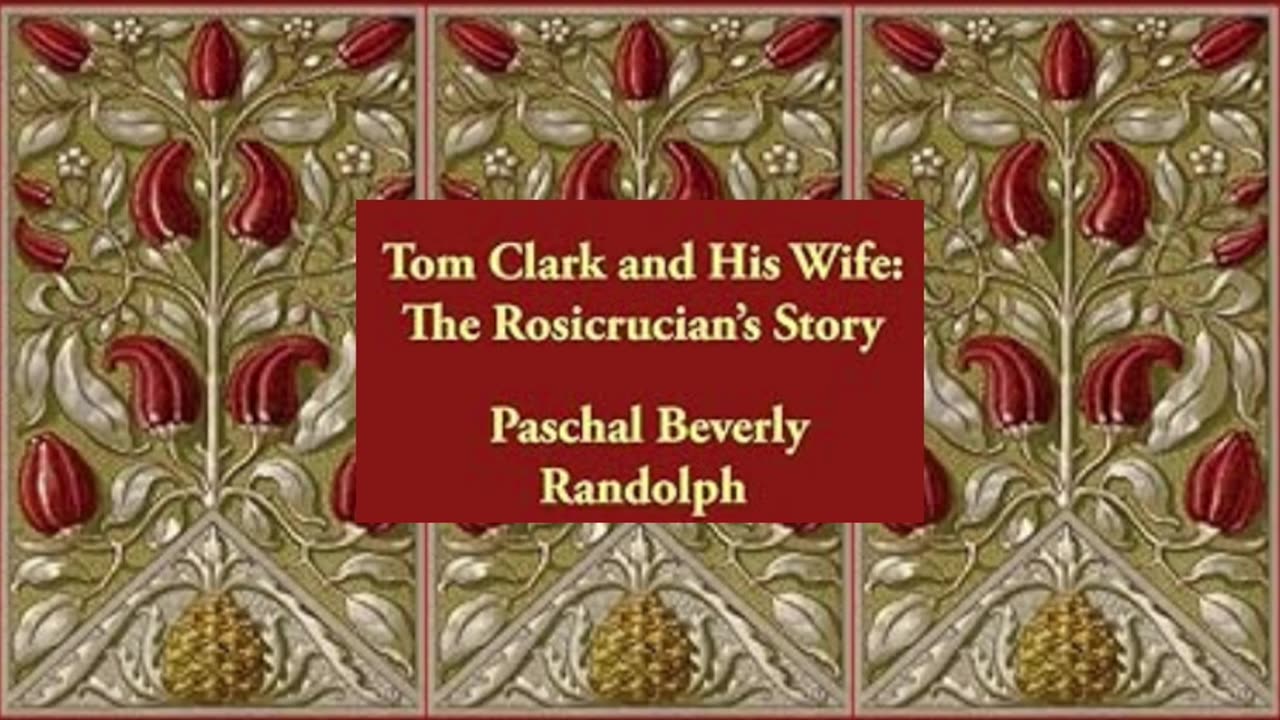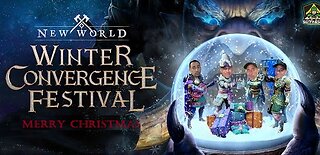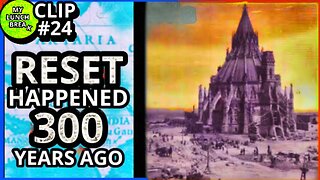Premium Only Content

Tom Clark and His Wife, the Rosicrucian's Story by Paschal Beverly Randolph (1863)
"Tom Clark and His Wife, the Rosicrucian's Story" by Paschal Beverly Randolph is a novel blending occult philosophy, spiritualism, and romance with an autobiographical undertone, reflective of Randolph’s deep engagement with esoteric traditions and Rosicrucianism. Published in 1863, the book is a unique hybrid of fiction and esoteric instruction, demonstrating Randolph’s commitment to sharing mystical knowledge through narrative storytelling.
Plot Overview:
The novel follows the life of Tom Clark, a man of humble beginnings who rises to higher levels of spiritual awareness through his encounters with Rosicrucianism. His journey is intertwined with his relationship with his wife, whom Randolph presents as a figure representing both earthly love and spiritual connection. Through their relationship, Randolph explores themes of marriage, sexual union, and spiritual enlightenment, reflecting his own teachings on the power of sexuality in spiritual development.
As Tom Clark grows in understanding, he is initiated into the Rosicrucian mysteries, learning the secret knowledge that allows him to transform his inner life and achieve a higher state of consciousness. This mystical knowledge is tied to Randolph’s broader belief in the power of self-suggestion, mental discipline, and sexual alchemy, principles that were central to his Rosicrucian teachings and later influential in the development of Western esotericism.
Key Themes:
1. Spiritual Transformation:
The central theme of the novel is personal transformation through spiritual knowledge and self-discipline. Tom Clark’s journey is one of self-discovery, where he learns the mysteries of the Rosicrucians and uses this wisdom to elevate his spiritual and personal life.
2. Marriage as a Spiritual Path:
The relationship between Tom Clark and his wife symbolizes sacred union. Randolph believed in the spiritual significance of sexuality and love, viewing marriage not just as a social institution, but as a potential path to spiritual awakening. This is reflected in Tom’s relationship with his wife, as their bond deepens through shared spiritual experiences.
3. Esoteric Wisdom:
As a Rosicrucian, Tom Clark is introduced to mystical secrets and occult practices that allow him to access hidden realms of knowledge. Randolph uses the novel to share elements of Rosicrucian philosophy, focusing on personal empowerment and esoteric wisdom.
4. Mystical Romance:
The novel is also a romantic story, where the love between Tom and his wife serves as a metaphor for the union between the human soul and divine wisdom. Their love is depicted as transcendent, representing the higher mystical truths that Randolph believed could be accessed through spiritual relationships.
5. Sexual Alchemy and Occult Practices:
In keeping with Randolph’s later works, the novel touches on the idea of sexual alchemy, the belief that sexual energy could be harnessed for spiritual purposes. Though not as explicit as his later writings on this subject, "Tom Clark and His Wife" presents sexuality as a sacred act that, when properly understood, can lead to spiritual enlightenment.
Significance and Influence:
"Tom Clark and His Wife" serves as an allegory for Randolph’s own beliefs and teachings. He was a pioneering figure in the Rosicrucian tradition in America and one of the earliest proponents of sexual magic in the Western esoteric tradition. This novel, therefore, offers not only a fictional narrative but also a guide to esoteric philosophy for those familiar with the symbolic language of the occult.
While not as widely known as Randolph’s other works, such as "The Mysteries of Eulis" or "The Ansairetic Mystery", this novel is an important early example of occult fiction and a precursor to later works that blend spiritual philosophy with narrative storytelling.
About the Author:
Paschal Beverly Randolph was a notable figure in the occult and esoteric circles of the 19th century. He had several Degrees, was a part of multiple Orders, and had many Fraternal Associations, including his ties to Freemasonry and other mystical traditions. Here’s a comprehensive list of the associations and degrees that Randolph is known for:
1. Rosicrucian Orders:
Fraternitas Rosae Crucis (FRC):
Randolph is best known for founding the Fraternitas Rosae Crucis, a Rosicrucian Order that still exists today. He was highly influenced by Rosicrucian teachings, focusing on alchemy, spiritual transformation, and sexual magic. This organization is recognized as one of the oldest American Rosicrucian societies.
2. Freemasonry:
While there are conflicting accounts regarding Randolph’s involvement in Freemasonry, some sources suggest that he was at least loosely associated with Masonic circles in his time. However, there is no definitive record of Randolph being formally initiated into any specific Masonic Lodge or attaining any degrees within the traditional Masonic structure.
Despite this, many of Randolph’s teachings, especially on esotericism and spiritual growth, resonated with Freemasonic ideals, and he maintained intellectual and fraternal relationships with several Freemasons throughout his life.
3. Hermetic Brotherhood of Luxor:
Randolph is sometimes linked to the Hermetic Brotherhood of Luxor, a secret society focused on practical occultism and spiritual development. While he may not have formally been a member, his work significantly influenced this group's practices and beliefs.
4. Spiritualism:
Randolph was a prominent figure in the Spiritualist movement, especially in the 1850s and 1860s. He conducted lectures and seances, where he discussed his experiences with mediumship and the spirit world. His connections to Spiritualist societies further solidified his reputation in esoteric circles.
5. Societas Rosicruciana in America (SRIAm):
Randolph’s Rosicrucian philosophy also aligned with the objectives of the SRIAm, an offshoot of the Societas Rosicruciana in Anglia (SRIA). Although there’s limited documentation of formal membership, Randolph's ideas deeply influenced Rosicrucian groups both in the U.S. and Europe.
6. Sexual Magic and Occultism:
Randolph pioneered teachings related to sexual magic in the West. He is credited with developing the concept that sexual energy could be used as a means for achieving higher spiritual states, which later influenced occultists like Aleister Crowley and members of the Ordo Templi Orientis (O.T.O.). Although Randolph wasn’t a member of the O.T.O., his work laid the groundwork for the sexual magick tradition later adopted by the group.
7. Egyptian Mysticism and Eastern Traditions:
Randolph traveled extensively, including to Egypt, where he studied various Eastern mystical practices. He was deeply influenced by the mysticism of the East, particularly in terms of spirituality, sexuality, and personal enlightenment, which he integrated into his own teachings and writings.
-
 47:13
47:13
Deus Meum Que Jus
26 days agoWilliam Cooper - Michael Schiffman, World Parliament of Religion - 9.8.93
484 -
 6:02:38
6:02:38
CLUJ
13 hours agoCHRISTMAS EVENING HYPE!! LETS HAVE FUN GAMING!!
63.6K7 -
![I AM FINALLY BACK :: PUBG: BATTLEGROUNDS :: RUMBLE NOW HAS GIFTED SUBS!!! [Merry Christmas] {18+}](https://1a-1791.com/video/fwe1/22/s8/1/e/f/C/6/efC6v.0kob-small-I-AM-FINALLY-BACK-PUBG-BATT.jpg) 9:57:19
9:57:19
a12cat34dog
15 hours agoI AM FINALLY BACK :: PUBG: BATTLEGROUNDS :: RUMBLE NOW HAS GIFTED SUBS!!! [Merry Christmas] {18+}
51.1K7 -
 3:55:42
3:55:42
STARM1X16
15 hours agoMerry Christmas Fortnite
125K11 -
 2:45:33
2:45:33
Sgtfinesse
15 hours agoMerry Christmas Night
90.4K19 -
 3:51:18
3:51:18
tacetmort3m
1 day ago🔴 LIVE - (MERRY CHRISTMAS) TIME TO SPREAD DEMOCRACY - HELLDIVERS 2 OMENS OF TYRANNY
54.4K2 -
 2:46
2:46
BIG NEM
18 hours agoDiscovering RAKIJA: The Holy Liquer of the Balkans
39.8K3 -
 1:11:38
1:11:38
Film Threat
23 hours agoCHRISTMAS DAY CHILL STREAM WITH CHRIS GORE | Hollywood on the Rocks
157K34 -
 14:22:40
14:22:40
The Quartering
1 day agoYule Log Christmas MAGA Edition With Memes! Come Hang Out!
245K32 -
 38:41
38:41
MYLUNCHBREAK CHANNEL PAGE
1 day agoTimeline Begins in 1800? - Pt 1 & 2
122K78